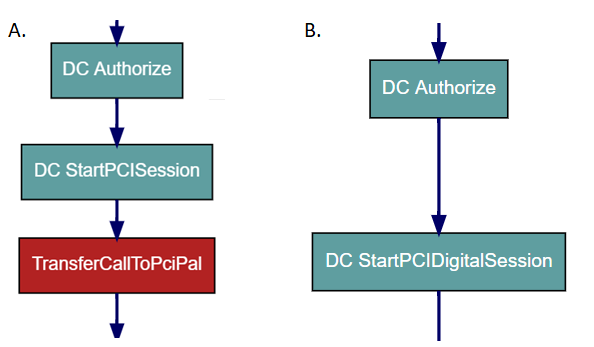Use the IVR Secure Payments solution to enable callers to pay for goods and services over the phone (self service) or using a payment link (digital) without interacting with an agent. For an overview of the payment facility, see IVR Secure Payments solution.
The following visualization shows the key stages of an example call plan for the IVR payment solution for both self service over the phone (A) and digital payments (B).

A more detailed description of an example IVR-based call plan is as follows:
Before Vonage Contact Center (VCC) starts the payment process in the platform's automated payment system, VCC must retrieve some data about the caller. Such data might include the balance of the payment to be taken and basic caller details such as name and address. The data required to start a payment session depends on the payment provider. Use one or more of the following applets to retrieve the required data:
The data that you retrieve using these applets is available at run time in appropriately named data sources.
In the case of digital payments, the data needed to be collected before starting the payment session is a phone number that will be used to send SMS with the payment link to. You can also use a caller phone number that is available as a data resource called CLID.
Configure the last applet you create at this stage to route to the Data Connector applet you create in step 2.
Before Vonage Contact Center starts the payment process in the automated system, VCC must route the data retrieved in step 1 to the automated payment system. Configure a Data Connector applet to use a Web Service interface. Authorize the user and send the data in the request as a header or in the body using two Data Connector applets:
Authorize—to authorize the user to start the session. In the below example, a call is made to the VCC Authentication API. For more information on the Authentication API, see Authentication API.
<ApiInteraction>
<Request>
<Url>~~~REPLACE~~~/auth/connect/token</Url>
<Method>POST</Method>
<Headers>
</Headers>
<Body><![CDATA[grant_type=client_credentials&scope=globalpci&client_id=~~~REPLACE~~~&client_secret=~~~REPLACE~~~]]></Body>
</Request>
<Response>
<Type>JSON</Type>
<ResponseCodeDestination>AuthorizeResponseCode</ResponseCodeDestination>
<Fields>
<Field>
<Locator>access_token</Locator>
<Destination>AccessToken</Destination>
<DataType>String</DataType>
</Field>
<Field>
<Locator>token_type</Locator>
<Destination>TokenType</Destination>
<DataType>String</DataType>
</Field>
</Fields>
</Response>
</ApiInteraction> |
Start Session—to start the payment session. The fields that this Data Connector uses in the Payment Data section—for example first name, surname, city, amount, currency and so on—vary depending on the payment provider. The account configuration ID is supplied by Vonage.
For the request to be processed successfully, you must include all fields mandatory to the payment provider in the Data Connector body. In the case of a digital session, the customer’s phone number is a mandatory field in the Payment Data section.
<ApiInteraction>
<Request>
<Url>~~~REPLACE~~~/globalpci/v1/selfservicesession/</Url>
<Method>POST</Method>
<Headers>
<Header>
<Key>Authorization</Key>
<Value>Bearer $(AccessToken)</Value>
</Header>
<Header>
<Key>Content-Type</Key>
<Value>application/json</Value>
</Header>
</Headers>
<Body>{"AccountConfigurationId":"~~~REPLACE~~~", "CallGuid": "$(CallGuid)", "PaymentData": { "cardholderName":"$(~~~REPLACE~~~)","cardholderPostCode":"$(~~~REPLACE~~~)", "cardholder Address": "$(~~~REPLACE~~~)","merchantTxnRef":"$(~~~REPLACE~~~)", "amount":"$(~~~REPLACE~~~)" } }</Body>
</Request>
<Response>
<Type>JSON</Type>
<ResponseCodeDestination>GlobalPCIResponseCode</ResponseCodeDestination>
<Fields>
<Field>
<Locator>dtmfFallbackNumber</Locator>
<Destination>PCIPal|DtmfFallbackNumber</Destination>
<DataType>String</DataType>
</Field>
<Field>
<Locator>dtmfLinkId</Locator>
<Destination>PCIPal|DtmfLinkId</Destination>
<DataType>String</DataType>
</Field>
<Field>
<Locator>sessionId</Locator>
<Destination>GlobalPCI|SessionId</Destination>
<DataType>String</DataType>
</Field>
<Field>
<Locator>Message</Locator>
<Destination>GlobalPCI|Message</Destination>
<DataType>String</DataType>
</Field>
</Fields>
</Response>
</ApiInteraction> |
<ApiInteraction>
<Request>
<Url>~~~REPLACE~~~/globalpci/v1/digitalselfservicesession/</Url>
<Method>POST</Method>
<Headers>
<Header>
<Key>Authorization</Key>
<Value>Bearer $(AccessToken)</Value>
</Header>
<Header>
<Key>Content-Type</Key>
<Value>application/json</Value>
</Header>
</Headers>
<Body>{"AccountConfigurationId":"~~~REPLACE~~~", "PaymentData": { "CustomerPhoneNumber":"$(~~~REPLACE~~~)","cardholderName":"$(~~~REPLACE~~~)","cardholderPostCode":"$(~~~REPLACE~~~)", "cardholder Address": "$(~~~REPLACE~~~)","merchantTxnRef":"$(~~~REPLACE~~~)", "amount":"$(~~~REPLACE~~~)" } }</Body>
</Request>
<Response>
<Type>JSON</Type>
<ResponseCodeDestination>GlobalPCIResponseCode</ResponseCodeDestination>
<Fields>
<Field>
<Locator>sessionId</Locator>
<Destination>GlobalPCI|SessionId</Destination>
<DataType>String</DataType>
</Field>
<Field>
<Locator>Message</Locator>
<Destination>GlobalPCI|Message</Destination>
<DataType>String</DataType>
</Field>
</Fields>
</Response>
</ApiInteraction> |
To transfer the call to the automated payment system, configure a Self Service Transfer to PCI applet. For information about the Self Service Transfer to PCI applet, see Self Service Transfer to PCI applet.
Select the data sources that contain the values retrieved in step 2.2 in the appropriate fields in the Transfer To PCI Self Service Settings section:
This part of the call is based on terms agreed between the customer and PCI-Pal—a PCI DSS compliant payment solutions provider. The PCIPal IVR normally requires the following data:
The PCIPal IVR informs the caller whether the payment was successful and transfers them back to VCC. You can optionally transfer the payment results to the VCC IVR Data Connector applet as defined in the next step.
If you want to route a customer differently based on a successful or failed payment, configure a Data Connector applet to retrieve the payment result from the automated payment system. VCC stores these values in data sources.
A session can have one of the following statuses:
Sometimes the session status is delayed for a few seconds after the payment session ends. |
In the example below, a call is made to the VCC Payment API to query the session status. For more information on the Payment API, see Payment API.
<ApiInteraction>
<Request>
<Url>~~~REPLACE~~~/globalpci/v1/session/$(GlobalPCI|SessionId)</Url>
<Method>GET</Method>
<Headers>
<Header>
<Key>Authorization</Key>
<Value>Bearer $(AccessToken)</Value>
</Header>
</Headers>
<Body></Body>
</Request>
<Response>
<Type>JSON</Type>
<ResponseCodeDestination>GlobalPCI|ResponseCode</ResponseCodeDestination>
<Fields>
<Field>
<Locator>sessionState</Locator>
<Destination>GlobalPCI|SessionState</Destination>
<DataType>String</DataType>
</Field>
</Fields>
</Response>
</ApiInteraction> |
Use the result for routing purposes only. The actual result of the payment might change, for example, due to the call being interrupted before returning to the VCC IVR. |
Configure a Data Router applet to route the call based on the payment result retrieved. You can configure, for example, the following scenarios:
Configure a Data Router applet to route the call after the digital session is started. You can configure, for example, the following scenarios: